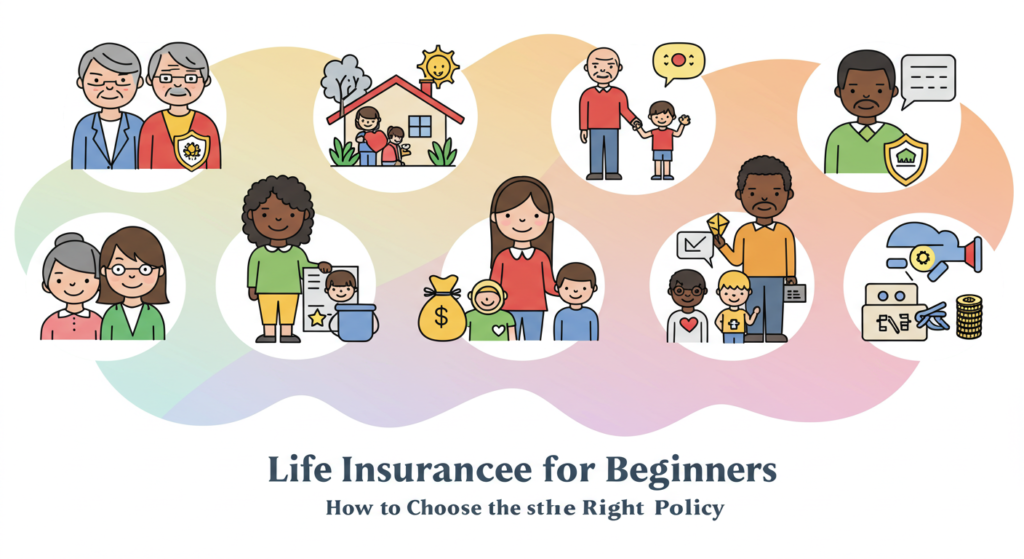Life Insurance for Beginners: How to Choose the Right Policy

Life insurance is a crucial component of financial planning, yet many beginners find it overwhelming to navigate the various options. Whether you want to protect your family, cover debts, or ensure financial stability, choosing the right life insurance policy can provide peace of mind. This guide will help you understand the basics and make an informed decision.
What Is Life Insurance?
Life insurance is a contract between you and an insurance company. In exchange for regular premiums, the insurer pays a lump sum (known as the death benefit) to your beneficiaries upon your passing. It’s designed to provide financial security for your loved ones.
Types of Life Insurance
Understanding the types of life insurance is key to selecting the right policy. Here are the main options:
1. Term Life Insurance:
- Overview: Provides coverage for a specific term, typically 10, 20, or 30 years.
- Best For: Affordable coverage for temporary needs, such as paying off a mortgage or raising children.
2. Whole Life Insurance:
- Overview: Offers lifelong coverage with a savings component (cash value) that grows over time.
- Best For: Those seeking long-term financial protection and cash value accumulation.
3. Universal Life Insurance:
- Overview: A flexible policy allowing you to adjust premiums and death benefits. It also includes a cash value component.
- Best For: Individuals wanting a customizable policy with investment potential.
4. Variable Life Insurance:
- Overview: Includes investment options for the cash value component, which can grow or shrink based on market performance.
- Best For: Those comfortable with risk and seeking investment opportunities.
Factors to Consider When Choosing a Life Insurance Policy
1. Assess Your Needs
- Determine why you need life insurance. Common reasons include:
- Replacing income
- Paying off debts
- Covering funeral expenses
- Funding education for children
2. Calculate Coverage Amount
- Use the DIME method:
- D: Debt repayment
- I: Income replacement (multiply your annual income by the number of years your family will need support)
- M: Mortgage balance
- E: Education expenses for dependents
3. Compare Premiums
- Get quotes from multiple insurers to find affordable rates that fit your budget. Factors affecting premiums include age, health, lifestyle, and policy type.
4. Evaluate the Insurance Company
- Look for:
- Financial stability (check ratings from agencies like AM Best or Moody’s)
- Customer service reviews
- Claims settlement ratio
5. Understand Policy Riders
- Riders are add-ons that enhance your coverage. Common riders include:
- Accidental Death Benefit: Extra payout for accidental death.
- Waiver of Premium: Waives premiums if you become disabled.
- Critical Illness: Provides funds if diagnosed with a severe illness.
Benefits of Life Insurance
- Financial Security: Ensures your family’s needs are met after your passing.
- Debt Coverage: Prevents financial burdens from unpaid debts.
- Savings Component: Whole and universal policies offer cash value accumulation.
- Tax Advantages: Death benefits are typically tax-free, and cash value growth may have tax-deferred benefits.
Common Mistakes to Avoid
- Underestimating Coverage Needs: Ensure the policy adequately supports your family’s financial needs.
- Procrastinating: Premiums increase with age, so purchase early.
- Overlooking Term Length: Choose a term that aligns with your financial obligations.
Steps to Buy Life Insurance
- Research and Compare: Explore different policies and providers.
- Get a Quote: Use online tools or consult with agents.
- Complete a Medical Exam: Many policies require health evaluations to determine premiums.
- Review the Policy: Understand the terms, premiums, and coverage.
- Purchase and Maintain: Pay premiums on time and update beneficiaries as needed.
Final Thoughts
Life insurance is a vital part of securing your financial future and protecting your loved ones. By understanding your needs, comparing options, and selecting the right policy, you can ensure peace of mind and long-term stability. Start today to lock in the best rates and provide a safety net for those who matter most.
FAQs
1. How much life insurance do I need?
Use the DIME method to calculate your coverage needs based on debts, income replacement, mortgage, and education expenses.
2. What is the best type of life insurance for beginners?
Term life insurance is often the best choice for beginners due to its affordability and simplicity.
3. Can I change my life insurance policy later?
Yes, many policies allow adjustments, especially flexible options like universal life insurance.
4. Is life insurance worth it if I’m single?
Yes, life insurance can cover debts, funeral expenses, and provide financial support to loved ones or charities.
Leave a Reply